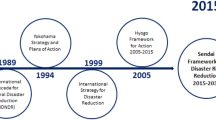Abstract
Globally, the number of disasters have increased during the last couple of decades. However, the common approach to disaster management is often limited to reactive mode. Only recently, research studies were initiated to understand the nature of disasters better and identify appropriate interventions and risks reduction approaches. But limited number of studies have explored the public health impacts of disasters to date. This is evident from the fact that the indicator set for “disaster-induced mortality” in the Sustainable Development Goals has no benchmark value. This chapter explores the link between natural disasters and various global health indicators to inform global health practitioners and researchers as well as to initiate a debate among policymakers about the importance of health data availability in pre- and post-disaster scenarios. Finally, the eminent role of evidence-based decision-making, interventions, and policies for natural disaster and risk management is highlighted.
Similar content being viewed by others
References
Abbas HB, Routray JK (2014) Vulnerability to flood-induced public health risks in Sudan. Disaster Prev Manag 23(4):395–419. https://doi.org/10.1108/DPM-07-2013-0112
Beresford, A., & Pettit, S. (2009). Emergency logistics and risk mitigation in Thailand following the Asian tsunami.Int J Risk Assess Manag 13(1), 7-21.
Checchi F, Gayer M, Grais R, Mills EJ (2007) Public health in crisis-affected populations. A practical guide for decision-makers. Humanitarian Practice Network, London
Coetzee C, Van Niekerk D (2012) Tracking the evolution of the disaster management cycle: a general system theory approach. Jàmbá: J Disaster Risk Stud 4(1), 9-pages
De Groeve T, Poljansek K, Ehrlich D (2013) Recording disaster losses. Recommendations for a European approach. European Commission Joint Research Center, ISPRA, Luxembourg
De Haen H, Hemrich G (2007) The economics of natural disasters: implications and challenges for food security. Agric Econ 37(s1):31–45
De Ville de Goyet C, Marti RZ, Osorio C (2006) Natural disaster mitigation and relief. In: Disease control priorities in developing countries. World Bank, New York
Denis H (1995) Scientists and disaster management. Disaster Prev Manag 4(2):14–19
EM-DAT: The Emergency Events Database (2015) Universite Catholique de Louvain (UCL) – CRED, D. Guha-Sapir – www.emdat.be, Brussels
EM-DAT: The Emergency Events Database (2016) Universite Catholique de Louvain (UCL) - CRED, D. Guha-Sapir - www.emdat.be, Brussels
Guha-Sapir D, Panhuis WG (2004) Conflict-related mortality: an analysis of 37 datasets. Disasters 28(4):418–428
Guha-Sapir D, Hoyois P, Below R (2013) Annual disaster statistical review 2012: the numbers and trends. CRED, Brussels
IPCC (2012) Managing the risks of extreme events and disasters to advance climate change adaptation. A special report of working groups I and II of the intergovernmental panel on climate change (ed: Field CB, Barros V, Stocker TF, Qin D, Dokken DJ, Ebi KL, Mastrandrea MD, Mach KJ, Plattner G-K, Allen SK, Tignor M, Midgley PM). Cambridge University Press, Cambridge, UK/New York, p 582
IWPR Institute for Women’s Policy Research (2010) Women, disasters, and hurricane Katrina. Factsheet #D492. IWPR, Washington, DC
Keller AZ, Al-Madhari AF (1996) Risk management and disasters. Disaster Prev Manag 5(5):19–22
Neumayer E, Plümper T (2007) The gendered nature of natural disasters: the impact of catastrophic events on the gender gap in life expectancy, 1981–2002. Ann Assoc Am Geogr 97(3):551
Noji EK (1997) The nature of disaster: general characteristics and public health effects. Oxford University Press, Oxford, UK, pp 3–20
Sawada Y, Bhattacharyay R, Kotera T (2011) Aggregate impacts of natural and man-made disasters: a quantitative comparison. RIETI discussion paper series 11-E-023. RIETI, Tokyo
Seneviratne SI, Nicholls N, Easterling D, Goodess CM, Kanae S, Kossin J, … Reichstein M (2012) Changes in climate extremes and their impacts on the natural physical environment. In: Managing the risks of extreme events and disasters to advance climate change adaptation. Cambridge University Press, Cambridge, pp 109–230
Shaluf IM (2007) Disaster types. Disaster Prev Manag 16(5):704–717
Spence R (2004) Risk and regulation: can improved government action reduce the impacts of natural disasters? Build Res Inform 32(5):391–402
Sweileh WM (2019) A bibliometric analysis of health-related literature on natural disasters from 1900 to 2017. Health Res Policy Syst 17(1):18. https://doi.org/10.1186/s12961-019-0418-1
Tschoegl, L., Below, R., & Guha-Sapir, D. (2006). An analytical review of selected data sets on natural disasters and impacts. Louvain: Centre for Research on the Epidemiology of Disasters.
Swiss Re (2014) Sigma No 1/2014. Natural catastrophes and man-made disasters in 2013
Turner BA, Pidgeon NF (1997) Man-made disasters, vol 2. Butterworth-Heinemann, Oxford
Turner BL, Kasperson RE, Matson PA, McCarthy JJ, Corell RW, Christensen L, … Polsky C (2003). A framework for vulnerability analysis in sustainability science. Proc Natl Acad Sci 100(14):8074–8079
UNISDR (2004) Living with risk: a global review of disaster reduction initiatives, vol 1. United Nations Publications, New York
Van Wassenhove LN (2006) Humanitarian aid logistics: supply chain management in high gear. J Oper Res Soc 57(5):475–489
Vinh Hung H, Shaw R, Kobayashi M (2007) Flood risk management for the RUA of Hanoi: the importance of community perception of catastrophic flood risk in disaster risk planning. Disaster Prev Manag 16(2):245–258
Watson JT, Gayer M, Connolly MA (2007) Epidemics after natural disasters. Emerg Infect Dis 13(1):1–5
Wijkman A, Timberlake L (1984) Natural disasters, Acts of god or acts of man? Earthscan, Chicago
Wisner B (2004). Assessment of capability and vulnerability. Mapping vulnerability: disasters, development and people. Earthscan, London, 183-193.
WHO (2009). WHO | Save Lives: Make Hospitals Safe in Emergencies. [Online] Available at: [Accessed 23 October 2019].
Yohe G, Tol RS (2002) Indicators for social and economic coping capacity – moving toward a working definition of adaptive capacity. Glob Environ Chang 12(1):25–40
Author information
Authors and Affiliations
Corresponding author
Editor information
Editors and Affiliations
Rights and permissions
Copyright information
© 2020 The Editors and the World Health Organization
About this entry
Cite this entry
Ahmad, J., Sadia, H. (2020). Natural Disasters. In: Haring, R., Kickbusch, I., Ganten, D., Moeti, M. (eds) Handbook of Global Health. Springer, Cham. https://doi.org/10.1007/978-3-030-05325-3_100-1
Download citation
DOI: https://doi.org/10.1007/978-3-030-05325-3_100-1
Received:
Accepted:
Published:
Publisher Name: Springer, Cham
Print ISBN: 978-3-030-05325-3
Online ISBN: 978-3-030-05325-3
eBook Packages: Springer Reference Biomedicine and Life SciencesReference Module Biomedical and Life Sciences




